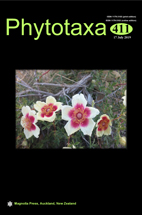Abstract
Rosa x binaloudensis, a new natural hybrid between R. beggeriana and R. persica is described and characterized after analyzing a set of morphological and molecular data. The putative hybrid with a small population occurs in the mountainous area of northeastern Iran. This taxon resembles R. beggeriana in having white corolla and pinnately compound leaves but its petals have red blotch at the base of each more similar to R. persica. In the morphological study we performed both the univariate and multivariate analyses. Results of Mann-Whitney U test show that among 62 vegetative and floral morphological traits used, 37 (59%) of the hybrid characters are parental-like, 14 (23%) traits are intermediate and 11 (18%) appear to be transgressive (both new and extreme characters). Multivariate analyses (PCoA) generally show that the hybrid is intermediate between its putative parents. In the molecular study we amplified, cloned, and sequenced ribotypes (nuclear rDNA-ITS region) of the hybrid, its putative parents and all members of the subgenus Rosa to detect their possible involvement in the hybridization. In addition to phylogenetic tree reconstruction, due to low molecular resolution among the ITS ribotypes, a phylogenetic network was also provided. Both the phylogenetic tree and haplotype network analysis confirmed the occurrence of the hybridization between the proposed parental species, R. beggeriana and R. persica. By using the chloroplastic trnL-F sequences, our phylogenetic reconstruction revealed that R. persica has played as a maternal role in the hybridization.

